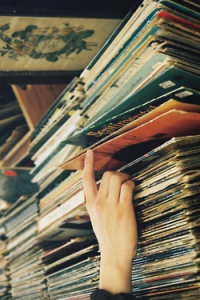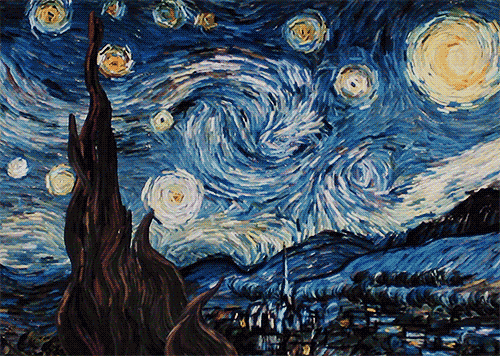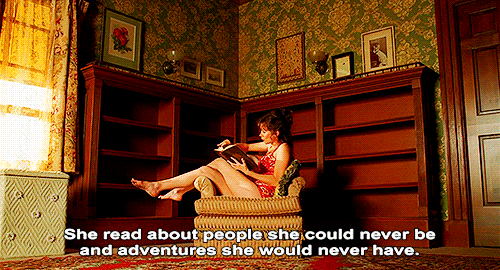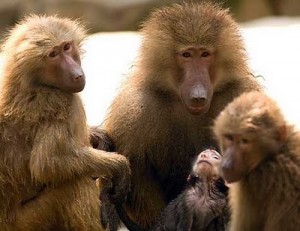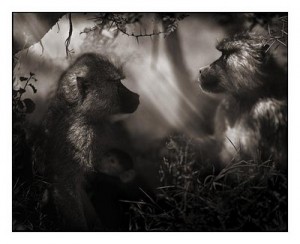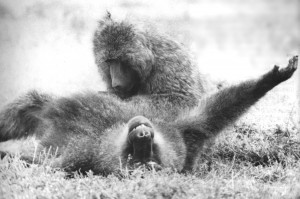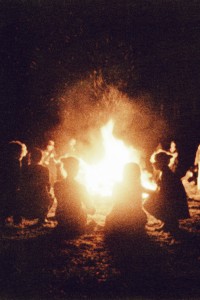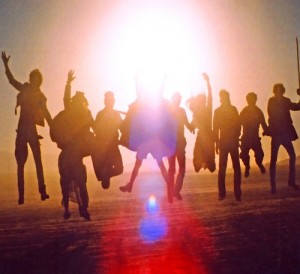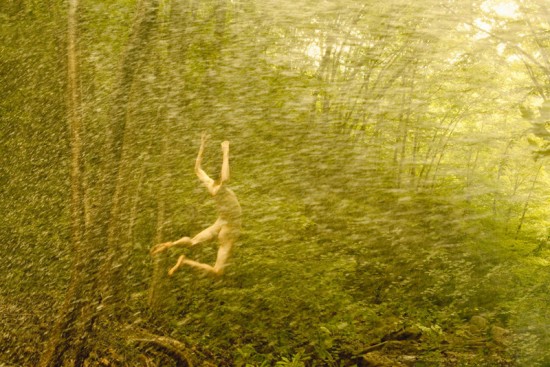
(Yoga Festival, August, 2011)
When I was a teenager – I’m so much younger than that now – I used to like to go out and see concerts, musical acts, movies, but whenever I did my favourite part was the bit we just went through. I mean the waiting, the anticipation, the hoped-for, what’s-it-going-to-be-like exactly? The collective dream that would take place as people slowly fill a room. I really love the sound of people filling a room. The shufflings, the searchings that people do with their hands, letting themselves be led by their feet, by some unspoken sense of geometry and design, the small universes of adjustments and readjustments. I wonder if you can hear it, can you hear it? As a kind of music. This music of gathering. Is it too much to name it the music of a certain kind of expectation, a certain kind of hope? Perhaps it is the music of our hope.
Could you feel this room when you stepped into it today? As it slowly filled. And because this is the third day, of a three day affair, in other words, the beginning of the end, some of you have been in other rooms in this building, maybe some of you have been in this room before. And each room, like every person, has a certain kind of – what the Buddhists like to call – vedana – or feeling tone. Each room has a certain kind of feeling tone. And it was so pleasurable this morning to feel the vedana in this room as each of you came in and found your place, because the tone of the room shifts in a subtle but unmistakable way as each person enters it.
You know many yoga classes – this thing we call yoga now – they sometimes begin or they sometimes end with everyone in the class doing a chant, for instance, chanting om. And this chanting turns everyone in the room into a member of the choir, and the choir creates a sound. It’s a sound that’s me and it’s you, it’s a sound that’s not me and not you, it’s the sound of us. It’s the sound of how only we could be together, in this moment, in this place. But there is a choir behind that choir, there is a sound that occurs beneath it – like the rubber you used to get underneath carpets, you know you have the beautiful part, the part that feels good, the carpet bit and then you had the rubber underlay to make it all soft, so if the carpet is the ommm, then the rubber cushion underlay is the silence. There’s a choir that’s happening right now, in this room, as we sit together. And this choir, this music, the music of this room, has been made possible because you’re here. It’s inseparable from you, from you being here. You are, we are, all of us, this music, in this room, as it’s playing right now.
Does anyone here know who Barbara Smuts is? She’s a very important anthropologist, primatologist, she spent some of her formative years in Kenya and Tanzania working with baboons. She spent two years in one particular stretch, just her and the baboons out in the fields. When they slept, where they slept, that’s when and where she slept. When they got up, she got up. Baboons are a bit nomadic, they wander in tribes and spend the twelve hours of daytime foraging for food, and Barbara very quickly noticed this thing about rainfall, you know these torrential showers would come down and she would get soaked if she didn’t run for cover, which she always did way before, way before the baboons did. They seemed to wait until the last possible second and then shazam they would all, as if they were connected with some invisible thread, as if they were all listening to the same song, as if they were part of the same music, they would just take off at a gallop for shelter, and the instant they were under cover, it would start to rain. Every time. They seemed to know exactly how long it would take them to get from wherever they were, to cover, they knew exactly when it was going to rain. In other words, they were practicing what the yogis call samadhi or integration, samadhi with the sky, samadhi with the clouds, samadhi with the thickness of the air. They experienced the period before the rain as clearly, and with as much articulation, as the rain itself. It’s like experiencing the silent choir in this room, that’s already singing the vedana of this room, as clearly as if we were all chanting om. The silence is speaking for these baboons in the moments before rainfall, it’s an articulate silence, and I say this in part because Smuts recounts that, to her own astonishment, after several months, she was able to do exactly the same thing. She too could sense the rain coming but instead of freaking and rushing for cover, she waited, she waited, and she didn’t wait with her calculations, she didn’t wait with her fear, instead, she waited with her whole body, until her whole human animal body knew, connected with all the other animal bodies, connected with sky and clouds, knew exactly when the first drops would fall, because she was that rainfall before the rainfall. In other words, she had studied very well, and very deeply, with her yoga teachers.
“Hey, what lineage are you from? Who was your samadhi teacher?”
“The gombe baboons in Kenya, just before the rainfall.”
I haven’t seen any baboons at the yoga fest yet, but of course it’s still early, maybe they’re saving the best for last. When I was a teenager I liked to go early to concerts so I could listen to all the people arriving. And then years later, a friend of mine was describing an experience that was like: going to the concert, and sitting with a lot of people, only… the concert never happens. “No way, they wouldn’t come if there wasn’t a band,” I assured him and he said, “No, no, it’s part of this old thing, this long line running back before your mother’s mother’s mother’s mother, can you hear it? Tuning in the DNA of a city.” He called it meditation.” “Meditation? You mean people just go to a room and sit there?” “Yes, yes,” he told me, “because the people who come are the music. The silence is something that you make, when you give your silence to others, it sounds like music.”
(And it’s not my silence, but I’m chipping in my part, and it’s not your silence.)
They haven’t come up with an app for silence yet, it doesn’t appear on eBay or Amazon or the Nasdaq. And you can’t do it on your computer.
When I can slow down, even just gear it down half a speed, I can’t help noticing that there’s so much going on in each moment, but usually I like to run my favourite records to keep me from hearing it. Yes it seems I’m forever reaching for my personal playlist, you know the one that says: you’re not working hard enough. You’re not working hard enough. You’re not working hard enough. The old songs, the old favourites, the ones that keep me separate, that keep me over here and you way over there. But like a lot of my friends, I’ve been getting tired of dragging around my old record collection, it takes up so much space, doesn’t it? I mean it takes up so much space here, in my body. And I can’t help but notice that it’s really hard to hear you, hard to hear you, hard to hear you, when I’m playing my favourite records. Sometimes I think I’ve been playing them my whole life. The truth is, I didn’t really know that it was possible not to play them, I mean they’ve been playing, one after another, for so long, I didn’t know that this radio station ever went off the air. I didn’t realize that there was an off switch, a way out, a downtime. But now like a lot of my friends I’ve decided to retire some of my old favourites, some of my old reliable hit tunes, you know the one where I turn the person I think I love into some version of my mother, OK, OK, maybe it’s still there in the back row of the back row of the jukebox, and then there’s all the cover tunes and remixes – it’s kind of the same song but there’s so many different you know versions of the song, so it seems like my life keeps changing, only it doesn’t, only I’m still out here on the savannah picking berries, getting soaked whenever it starts to rain.
But sometimes I remember to breathe, I follow the breath the way Barbara Smuts followed her baboon teachers, and my breath doesn’t kill the jukebox, it doesn’t destroy the radio station, but it gives me some space from those old tunes, so that sometimes I can hear them simply as music, instead of my music, my necessary compulsion, and when I can do that, when I can turn the turnings of consciousness, the citta vrttis, into something sacred, I realize that my most perfect and excellent teacher, the breath, is always leading me back here, here, to this moment, which is the only moment that practice can happen.
Some of my friends wonder why I don’t want to go out with them to concerts anymore, they say to me, “Oh, that’s so selfish, you’re just sitting there on a cushion by yourself.” But I think, “No, no, often in the rest of my life, I can be selfish. Playing those old records, clinging on to some old version of myself, covering the so-muchness of what’s happening right now with my songs, that is selfishness, that is the root of selfishness. But to do this, to sit in the mudra of the Buddha, to sit like the Buddha, with you, to lend my silence to your silence, to chip in my part, to do my bit, to become part of the choir of silence, this feels like community, this feels like the most delicious, the most beautiful kind of music.
